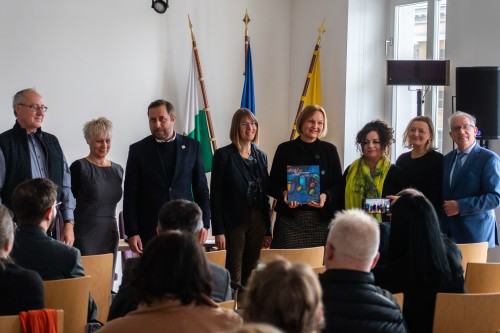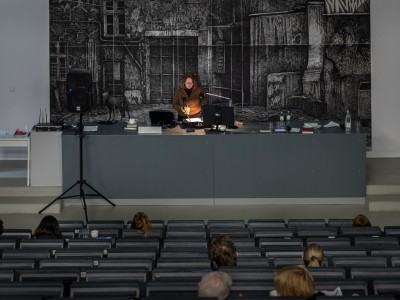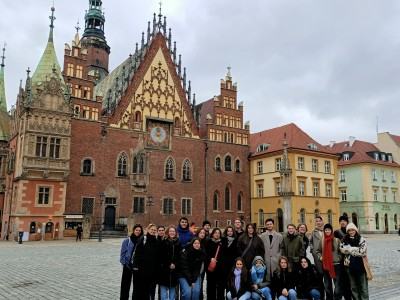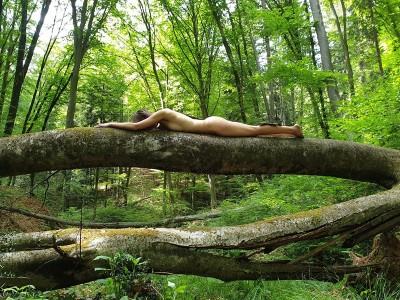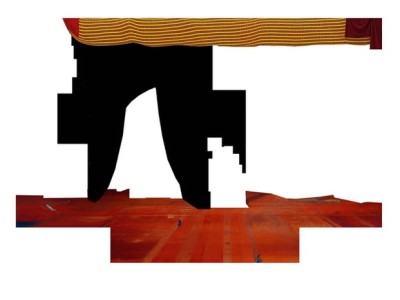International research symposium “Sorbian painter Jan Buck – Wrocław contexts”
The international symposium “Sorbian painter Jan Buck – Wrocław contexts” was realised as part of the long-term research project “Hommage à Jan Buck” (2022–2025) under the scientific direction of Ph.D Lidia Głuchowska, initiated at the Institute of Visual Arts of the University of Zielona Góra. The previous conferences in the series, with a complementary programme, were organized in Lusatia – in Budziszyn/Bautzen and Chóśebuz/Cottbus.The present one took place in Wrocław, as one of the first students of the local Academy of Fine Arts after World War II was Jan Buk/Buck, a reformer of Sorbian art. He led it out of the exclusive sphere of folklore, where it had been stuck because of its resistance to assimilation into the dominant German culture, and – under the impulse of the Lower Silesian capital rising from the ruins – set it on the path to integration into European and world modernism. His achievements are emblematic of the efforts of the indigenous Slavic inhabitants of present-day East Germany within the administrative borders of Saxony and Brandenburg to preserve their own identity.
The almost 100 participants in the event described above witnessed and were very active participants in a lively interdisciplinary debate on the history and present of art in the Polish Western Territories and the tradition of the Academy in Wrocław, as well as on the dynamics of Polish-Sorbian and Polish-Saxon and Polish-Sorbian and Sorbian-German cultural relations.
The symposium was opened by the director of the Wrocław Saxon Office, Anna Leniart, and chaired by the scientific director, Ph.D. Lidia Głuchowska, Ph.D. Anita Wincencjusz-Patyna from the Eugeniusz Geppert Academy of Fine Arts and Ph.D. Sylwia Świsłocka-Karwot from the Institute of Art History at Wrocław University, director of the Wrocław Contemporary Museum. Those in attendance were enthusiastically greeted by Ms Kerstin Nielsen – Vice Consul of Germany in Wrocław, Prof. Wojciech Pukocz – Rector of the Wrocław Academy of Arts, Prof. Stefan Kiedroń – Vice Rector of the University of Wrocław, Prof. Paulina Komorowska-Birger – Director of the Institute of Visual Arts at the University of Zielona Góra, and Christina Bogusz/Boguszowa – Director of the Sorbian Museum in Budyšin/Bautzen.
As many as 12 speakers participated in the very condensed agenda.
Ph.D. Lidia Głuchowska illuminated the perspectives of the decentralisation of the art history canon in the context of its “peripheries” – including the Polish Western Territories and Lusatia, by screening and commenting on her film from the series “Hommage à Jan Buck”, made together with Anna Mazurkiewicz. Ph.D. Robert Lorenc/Lorenz from the Sorbian Institute in Bautzen, presented historical maps and paintings by Jan Buk/Buck, his female students and other native artists to define the concept of the cross-border region Lusatia. Jędrzej Soliński (Sorbian Museum Bautzen/University of Wrocław) made a complicated attempt to reconstruct two Jan Buk/Buck exhibitions in Wrocław in 1978 and 1982. Silke Wagler (Dresden State Art Collections/Kunstfonds) introduced the audience to the monumental art of the Sorbian artist, while the current professors of the Wrocław Academy of Fine Arts, Ph.D. Tomasz Mikołajczak and Ph.D. Marek Śnieciński, provided an insight into the curriculum of the early post-war education in sculpture and painting. Significantly, in presenting the achievements of their academy, they showed archive photographs, which were not only documentation of the work of its post-war founders, but also works of art by outstanding photographers.
The afternoon part of the session was conducted as a “round table” – with the participation of witnesses from the epoch and people involved in the restoration of the Lusatian legacy in the territory of the present Lubuskie and Lower Silesian Voivodships. Pětr Buk/Peter Buck – the artist's son – pointed out his father's long-standing links with the Polish artistic community, presenting his photographs and notebooks from the State Visual Arts High School in Wrocław. Those gathered unanimously agreed that copies of these unique documents should be placed in the Academy's archives.
The doyens of the Wrocław Academy of Arts – Anna Szpakowska-Kujawska and Prof. Michał Jędrzejewski, who began their studies just after Jan Buk/Buck - recalled its “luminous” pre-war and early post-war history and the “darkness” of the socialist realist era. Sorabist, Ph.D. Malgorzata Mieczkowska (Institute of Sciences on Politics and Security at the University of Szczecin), who had been in contact with Jan Buk/Buck for years, organised meetings of Szczecin political scientists in his hometown Nebelčicy/Nebelschütz near Budyšin/Bautzen, as well as a related conference and exhibition at the National Museum in Szczecin, spoke about the problems of the denationalisation of the Sorbian population in Germany and Poland. In turn, Katarzyna Majbroda, Ph.D. (University of Wrocław, Institute of Ethnology and Cultural Anthropology, University of Wrocław, Vice-President of the Polish Folklore Society) and Elżbieta Lech-Gotthardt (Association Dom Kołodzieja in Zgorzelec) spoke in a dialogue about the depopulated Lusatian villages in the tri-junction of Poland, Germany and the Czech Republic – seized by the Turów mine, like almost 80 other villages on the German side of the border – including Wigancice (former German: Weigsdorf) in particular – as well as projects for the reconstruction of Lusatian material culture supported by, among others, the Poznań University of Technology. Their speeches were accompanied by a silent witness – a toy teddy bear from the house of a seamstress, probably the last Sorbian woman in the area, who is still remembered by the inhabitants... The daughter of a persecuted pro-Lusatian activist, Ludmila Gajczewska, read out her Serbian poem published earlier in the “Rozhlad” magazine as a touching closing act.
The statements of the last two speakers referred directly to the exhibition at the Saxon Office in Wrocław, the opening of which took place as part of the proceedings – “Hommage à Jan Buck (III): Tomasz Mielech: Footsteps of memory – the Lusatian cultural legacy in Lower Silesia”
(curator: Lidia Głuchowska).
The artistic setting for the symposium included also two other exhibitions of artworks. The first was a retrospective exhibition of Jan Buck/Buck in the Royal Palace, enriched with works by his teachers and colleagues from the Wrocław Academy, as well as his Sorbian female students. The guided tour took place on the eve of the conference. The students, under the supervision of Joanna Legierska -Dutczak visited it a day later with Magdalena Szmida-Półbratek, a curator from the Museum of the City of Wrocław. The second of these exhibitions is “Hommage à Jan Buck (III): TAMED” at the Arsenal in Wrocław – a joint work by 42 artists from the Wroclaw Academy and the Institute of Visual Arts, the University of Zielona Góra. The meeting in Arsenal was concluded with a festive banquet and talks with the creators of this special exhibition – for the first time bringing together two artistic communities from the Polish Western Territories to such an extensive extent.
Patrons of the event and the whole project “Hommage à Jan Buck” are:
Minister President of the Free State of Saxony, Michael Kretschmer
Minister President of the State of Brandenburg, Dr Dietmar Woidke
Consul General of the Federal Republic of Germany in Wrocław, Martin Kremer
Marshal of the Lower Silesian Voivodship, Cezary Przybylski
former Marshall of the Lubuskie Voivodship, Elżbieta Anna Polak
Rector of the University of Zielona Góra, Prof. Wojciech Strzyżewski
Rector of the Eugeniusz Geppert Academy of Fine Arts in Wrocław, Prof. Wojciech Pukocz


